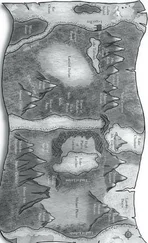Alex stared past Ed at the bank of dark clouds swallowing up the remaining patches of blue sky. He doubted they would reach the crossing before the rain, which suited him fine. The rain would mask their approach. One way or the other, this Jeep would negotiate the border at Milton Mills. The choice between a hard or soft negotiation rested with the people guarding the bridges.
EVENT +29:52 Hours
Sanford, Maine
Harrison Campbell approached the red-sided barn along a worn dirt path, nodding to his second in command, who stood in the barn’s open bay door. He glanced momentarily at the assembly of vehicles parked on the worn grass in front of the barn, noting the mix. A few economy sedans and an old Subaru Forrester. They’d need full-size SUVs and pickup trucks to handle regular supply delivery and general hauling. He supposed they should be thankful. None of them had put much faith in the latest rendition of the government’s Critical National Infrastructure report. He’d gladly take a few beat-up sedans over nothing.
When he reached the barn door, his deputy commander rendered a salute, which Campbell returned. Glen Cuskelly was dressed in woodland camouflage fatigues, with the York County Readiness Brigade patch displayed prominently on his right shoulder. A second patch was Velcroed to his left breast pocket, identifying him as the brigade’s deputy commander. Tan combat boots and a black baseball cap imprinted with the brigade’s logo completed the uniform, which Harrison insisted all of the county-level chapter leaders wore in the field or in public.
He had led the York County Readiness Brigade, formerly known as the York County Militia, through a public perception transformation over the past several years. Long gone were the days of mismatched uniforms, public displays of military-style weaponry and weekend tactical assault training. The word militia had become synonymous with gun-toting, doomsday-fearing, antigovernment revolutionaries, which couldn’t be further from the true purpose of his group.
Harrison had worked tirelessly, often fruitlessly, with the media to change this perception, which had suffered a major setback during the 2013 pandemic. At the height of the Boston exodus, the Kittery chapter decided to blockade the two major bridges over the Pisqataqua River, in an attempt to stem the tide of violence and looting that had engulfed York County. State police, backed by heavily armed elements of the Maine National Guard, had to forcibly remove the group after militia members fired into a sedan trying to plow through the roadblock, tragically killing a young family.
The unfortunate incident went mostly unnoticed until it was revived in early 2015 by a national magazine, in a two-part exposé on the rising number of armed antigovernment groups “training for revolution.” Despite the fact that membership was still on the rise, for the first time in over a decade, the York County Militia was politely declined a place in several important Memorial and Independence Day parades.
The message was less than subtle. The York County Militia was no longer welcome by town hall. Harrison Campbell decided to steer the public’s focus away from the guns and back to the organization’s core values: self-reliance, preparedness and community service. Efforts to regain community trust moved slowly, but 2019 marked the first year that the former York County Militia had marched in parades through Biddeford, York, Kennebunk and Sanford.
“Brigade leadership is formed, sir,” said Cuskelly.
“Thank you, Glen. What are we looking at?”
“Brian showed up a few minutes ago, which puts us at three out of the seven commanders,” Cuskelly replied.
“Still no word from the York or Kittery chapters?”
“Nothing yet. Reports from the area aren’t encouraging. It looks like a total wipeout east of the turnpike.”
“And Limerick?” asked Campbell.
“Randy’s radio must be down. We haven’t heard from him since about eight last night. He knows about the meeting,” said Cuskelly, shrugging his shoulders.
“It’s not like Randy to blow off his duties. He’ll show up. Let’s get this moving along, so everyone can get back out to their people,” said Campbell, stepping inside the York County Readiness Brigade’s headquarters.
The barn’s recently renovated interior contained a single, wide-open, post-and-beam interior from front to back, featuring vaulted arches and struts running the entire length of the ceiling. An unfinished oak-board floor held up several rows of rough-cut timber benches, giving the space the distinct feel of a rural Grange hall. A thick, hand-hewn, pine table sat lengthwise in front of the benches at the far side of the barn, surrounded by the brigade leadership team, all of whom leaned over a map, talking excitedly. Several additional maps adorned the far right corner walls, within easy reach of the ham radio station.
The brigade banner towered over them, draped across the floor-to-ceiling flagstone fireplace anchoring the far wall. The royal blue flag displayed their motto, “Semper Tuens” (always protecting), in gold letters above a simple picture of a colonial minuteman. “YCRB” was printed under the minuteman, representing the only change to the banner in thirty-three years. The American flag and Maine state flags flanked the fireplace, attached to thick wooden poles in black iron stands. The poles were canted away from the fireplace at forty-five degree angles to allow the unfurled display of each flag. From the back of the barn, it was an awe-inspiring sight that filled him with pride.
The Campbell family barn and the two hundred surrounding acres had served as the York County Militia’s headquarters and meeting place since its inception, hosting everything from small leadership meetings to the town-hall-style public relations events that had become more common recently. The personally funded renovation effort had transformed the damp, dingy barn into a warm, inviting space for these events. They could hardly transform public perception in the propane-lantern-lit, creaky old barn that had served them for years.
The men around the table stood at loose attention when he walked down the aisle between benches.
“At ease, everyone. Why don’t we all take seats for now? We’ll get to the maps a little later,” he said, pulling a chair out for himself in the middle.
“Thank you for making the trip under less than optimal circumstances. I know you have your own families and people to look after, so I won’t keep you long. Obviously, we’re missing some folks,” he said, and the group murmured. “I want you to stay focused on your own areas of responsibility for now. Once we’ve sorted out how to make the best impact within each of your chapters, we’ll explore ways to expand east and help. Let’s conduct a quick SITREP from each chapter and see where we stand for now. Gerry?” he said, nodding to the Biddeford/Saco chapter commander.
“Coastal areas were hit hard, which is no surprise,” said Gerry Beaudoin. “Old Orchard Beach is a total loss. Biddeford and Saco downtown areas were relatively untouched, aside from a massive surge of water down the Saco River. Messed up the riverfront areas something fierce. We have trees down and windows shattered all over, but the heavily populated areas were spared the tsunami effects. Downtown Biddeford is nearly four miles from the coastline.”
“That’s good news, Gerry. I know you live out past the 95, so I assume your outreach supplies are still intact?” said Campbell.
“Yep. I have the stuff split between my deputy commander and a few other trusted members. Tents, tarps, fuel, dried stores—all maintained according to brigade readiness standards.”
Читать дальше












